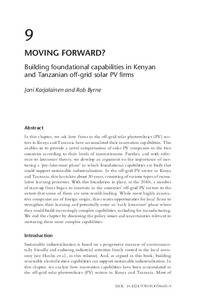Moving forward? Building foundational capabilities in Kenyan and Tanzanian off-grid solar PV firms
Karjalainen Joni; Byrne Rob
https://urn.fi/URN:NBN:fi-fe2022012710946
Tiivistelmä
In this chapter, we ask how firms in the off-grid solar photovoltaics (PV) sectors in Kenya and Tanzania have accumulated their innovation capabilities. This enables us to provide a novel categorisation of solar PV companies in the two countries according to their levels of innovativeness. Further, and with reference to latecomer theory, we develop an argument on the importance of nurturing a ‘pre-latecomer phase' in which foundational capabilities are built that could support sustainable industrialisation. In the off-grid PV sector in Kenya and Tanzania, this has taken about 30 years, consisting of various types of cumulative learning processes. With this foundation in place, in the 2010s, a number of start-up firms began to innovate in the countries' off-grid PV sectors to the extent that some of them are now world-leading. While most highly innovative companies are of foreign origin, this creates opportunities for local firms to strengthen their learning and potentially enter an ‘early latecomer' phase where they could build increasingly complex capabilities, including for manufacturing. We end the chapter by discussing the policy issues and uncertainties relevant to nurturing these more complex capabilities.
Kokoelmat
- Rinnakkaistallenteet [19207]
